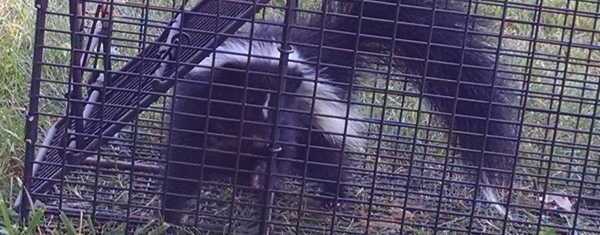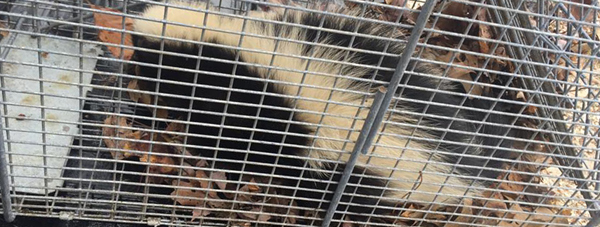- info@wildlife-removal.com
Call us for help in your town
Wildlife Removal Education
About Skunks: Biology Information
Need skunk removal in your hometown? We service over 500 USA locations! Click here to hire us in your town and check prices - updated for year 2020.
The skunk is also known as Polecat. There are 11 known species of skunk and most of them live on the American continent. Skunks are able to transfer rabies, a lethal brain infection to humans and other mammals by biting, but this is not so common.

Physical Appearance
The skunk measures an average 40 – 70cm in height and weighs pretty much the same as a household cat. Skunks are black and white in color but there are some variants and they all have stripes. It has a bushy tail that is marked with black and white rings.
Behavior
Skunks generally have poor vision and can barely see objects that are more than 3meters away. This predisposes them to high mortality on roads as they do not see approaching vehicles until too late. They however possess excellent senses of smell and hearing.
They are most popularly known for their defensive reaction of releasing a foul, strong smelling secretion from its rear end when threatened. The offensive smell of this secretion is effective in discouraging would-be attackers as it persists for days if sprayed on anything within a 10-foot distance. The spray can also cause irritation and temporary blindness. Its major predators are coyotes, bobcats, and owls
Feeding
Skunks are omnivores and opportunistic feeders. Common animal foods include worms, rodents, and even small reptiles like lizards, salamanders, frogs, snakes. They often hunt insects and insect larvae, poultry, eggs and small mammals. They are also known to attack beehives to eat honeybees as their thick fur protects them from stings.
As for plants, they often feed on garden vegetables and fruits, berries, grasses, and roots. They often dig small holes in the soil looking for insect larvae.
In urban and suburban areas, skunks forage and eat from household garbage cans and leftover pet food. Less commonly, they are scavengers, feeding on the carcass of birds and rodents killed by cats or other animals.
Reproduction
The male skunk is called a buck, female – doe, and baby – kit. The birth of 2 to 10 kits usually takes place in May, 7 to 10 weeks after mating takes place. The female skunk would dig out a birth burrow to have her babies in. The kits are born blind and without any teeth, they are also unable to use their defensive spray at first. These features usually develop over a few weeks and the babies stay with their mother for about a year. The mother is protective of her babies and sprays at any perceived sign of danger
Go back to the Skunk Removal page.
Read more skunk information here:
Should I feed a baby skunk I found?
What should I do if I find an orphaned baby skunk?
What should I do if I find a nest of baby skunks?
Do Baby Or Juvenile Skunks Spray?
What is the best bait to trap a skunk?
Is it Safe to Handle a Skunk with Bare Hands?
Do Skunks Burrow Underground?
Do Skunks Attack Chickens?
Is a skunk that is active during the day time rabid?
How to find and remove a dead skunk
What is a skunk's natural diet?
Why do skunks dig?
What equipment is needed to trap a skunk?
Is skunk feces dangerous to touch or breathe?
Do Skunks Fight Each Other?
How to use one-way exclusion funnels to remove skunks
How to keep skunks out of my garage
How to keep skunks out of my garbage cans
Where do skunks live?
What are some humane ways to kill a skunk in a trap?
What if a skunk got inside my house?
Will the city or county animal services help with a skunk issue?
What is a skunk's mating habits?
Do Skunks Come Out During The Day?
Will a pest control company help to remove skunks?
Are Skunks Good Pets?
Are Skunks Good Pets?
When Do Skunks Shed Their Fur?
Best Ways to Remove Skunk Smell From Your House or Car
Is A High Pitch Sound Deterrent Machine Useful Against Skunks?
Best Ways To Protect Yourself From Skunk Sprays
Can A Skunk Spray Multiple Times At Once?
Can Skunks Swim?
Why Skunks Spray
Skunks
There are 11 known species of skunk and most of them live on the American continent. Also known as the polecat, the skunk measures an average 40 – 70cm in height and weighs pretty much the same as a household cat. The male skunk is called a buck, female – doe, and baby – kit.

It is most popularly known for its defensive reaction of releasing a foul, strong smelling secretion from its rear end when it feels threatened. Skunks are also able to transfer rabies, a lethal brain infection to humans and other mammals by biting but this is not so common.
Physical Appearance
The color of the skunk varies from the typical black and white to grey, cream and sometimes brown. All skunks however, whether young and mature have striped markings, regardless of their color. The tail is bushy and very hairy, much like the tail of a Fox and marked with black and white rings. It has a moderately elongated body with legs that are muscular and relatively short in comparison; its long front claws are modified for digging burrows in the earth.
Behavior
Skunks rarely live or move in groups, they are generally solitary animals aside from breeding periods. Female skunks that live in colder regions are however known to inhabit burrows in groups for warmth. Skunks den up for extended periods of time in the winter and don’t feed as much, though they do not go into hibernation. They make use of their long front claws to dig these burrows and usually hide in them during day time.
They generally have poor vision and can barely see objects that are more than 3meters away. This predisposes them to high mortality on roads as they do not see approaching vehicles until too late. They seem to make up for this with excellent senses of smell and hearing though. The animal can run only 10 miles per hour. Skunks are plagued by a short life span – from as little as 1 year to 5 years in the wild and up to 10 years in captivity.
Defense
When feeling threatened, the skunk produces a smelly oil from two glands near its anus. The offensive smell of this secretion is effective in discouraging would-be attackers as it persists for days if sprayed on anything within a 10-foot distance. The spray can also cause irritation and temporary blindness. A skunk that is about to spray its victim would turn its back and stomp its feet while hissing with its body quivering. It is in a person’s best interest to look out for these signs when within the vicinity of a skunk. Its worst enemies are coyotes, bobcats, and owls
Feeding
Skunks are omnivorous and their diet changes with the seasons. Common animal foods include worms, rodents, and even small reptiles like lizards, salamanders, frogs, snakes. They often hunt insects like crickets, grasshoppers, beetles, cutworms and various insect larvae. Skunks sometimes eat poultry, eggs and small mammals. Skunks are also known to attack beehives to eat honeybees as their thick fur protects them from stings.
On the plant side, they often feed on garden vegetables and fruits, berries, grasses, and roots. They often dig small holes in the soil looking for insect larvae.
In urban and suburban areas, skunks forage and eat from household garbage cans and leftover pet food. Less commonly, they are scavengers, feeding on the carcass of birds and rodents killed by cats or other animals.
Reproduction
The birth of 2 to 10 new skunk babies (kits) usually takes place in May, 7 to 10 weeks after mating takes place. The female skunk would dig out a birth burrow to have her babies in. The kits are born blind and without any teeth, they are also unable to use their defensive spray at first. These features usually develop over a few weeks and the babies stay with their mother for about a year. The mother is protective of her babies and sprays at any perceived sign of danger.
Go back to the Skunk Removal page.


















